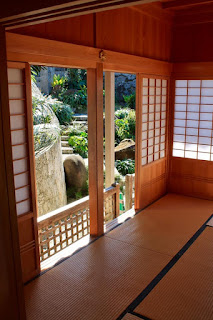Vielen ist Okinawa ein Begriff aus dem 2. Weltkrieg, denn der Widerstand gegen die Amerikaner war hier besonders erbittert, verzweifelt und auch zweifelhaft. Das schiffseigene Reisebüro bietet bei jedem Landgang verschiedene Ausflüge an, hier auch einen, der Orte besucht, die den Kampf der Uchinānchu, der Bewohner Okinawas im südpazifischen Krieg dokumentieren. Ich war versucht, aber habe mich dann doch entschieden, die Burg zu besuchen, ich alleine für mich, ohne Reisegruppe und so. Heute, ich schreibe mehr als zwei Jahre nach meinem Besuch, bin ich sehr froh, dort gewesen zu sein, denn am 31.10. 2019 ist die Burg komplett abgebrannt. Brandursache war vermutlich ein defektes Kabel und nun sind 4200 Quadratmeter zerstört und über 400 wertvolle Artefakte verloren.
Aber die Burg hat auch zuvor schon viel erlebt. Die Anlage stammt aus dem 14. Jahrhundert und war anfangs nur ein Pavillon auf der gleichnamigen Anhöhe. Und mit den Jahren und Herrschern wuchs die Burg, es kamen viele Tore hinzu, im 16. Jahrhundert der Palast und als die nördlichen Inseln 1627 unter die Herrschaft der Shimazu aus Satsuma kamen, wurden die Delegierten von König Shō Hō im eigens errichteten Südpalast empfangen. 1660 brannten alle Paläste ab, wurden wieder errichtet und mit Ziegeln gedeckt, aber 1709 brannte es wieder, trotz Ziegel und nun kamen die Shimazu zu Hilfe beim Wiederaufbau. 1846 wurde umfassend restauriert und 1879 erging der Befehl der König möge die Burg aufgeben. Okinawa wurde Teil des japanischen Kaiserreichs.
Am 12.Mai 1945 wurde die Burg in der Schlacht von Okinawa vollständig zerstört. 1958 wurde das Shurei-Tor wieder errichtet, 1992 war der Hauptpalast fertig, andere Gebäude folgten. Im Jahr 2000 erklärte die UNESCO die noch erhaltenen Reste aus der Zeit vor der Rekonstruktion zum Weltkulturerbe als Bestandteil "Archäologischer Stätten des Königreichs der Ryukyu-Inseln".
Die Burg unterscheidet sich durchaus von anderen Burgen, die ich aus Japan kenne, es gibt nicht den einen hohen Burgturm mit fünf bis sieben Stockwerken auf einer hohen Mauer, sondern hohe Mauern mit kleineren Türmen, die die Paläste verbergen.
Allerdings sind Ornamentik und farbliche Gestaltung doch wieder ähnlich, etwas, das mir auch noch in Taiwan und Hong Long auffallen wird. Aber hier in Europa ist es ähnlich, es gibt durchaus landes- oder gebietstypische Architektur und dann auch wieder Elemente, die sich fast überall finden.
English version below
Many people heard of Okinawa´s role in the WWII, the resistance against America was fierce, desperate and questionable. The ship company´s own travel agency offers for every shore leave special tours and here was one, guiding us to the places of the resistance of the Uchinānchu, the name of the Okinawa people, in the south pacific war. I was thinking about that, but changed my mind and went to see Shuri Castle instead, because I can go there on my own with no group at my heels. Today, I writing about this journey more than two years later, I´m glad, I did go, because October 31st 2019 are big fire destroyed the castle nearly completely. An electrical defect seems to be the reason for the fire, and 4200 sqm are burned down to the grounds and more than 400 precious artifacts are lost.
But even before that the castle went through a lot. The first building war erected in the 14th century and it was just a pavilion on a hill with the same name. And with the years and the rising kings the castle was growing too, there were gates added and in the 16th century the first palace was built and when the norther islands where conquered by the Shimatsu from Satsuma, the delegation was welcomed in the south palace, built only for them. In 1660 a fire destroyed all the palaces of the castle and the were rebuilt and the roofs got tiles then. Even with tiled roofs there was another fire in 1709 and this time the Shimatsu helped with the reconstruction. In 1846 a lot of renewing was done and in 1879 the king got the order to give up the castle. Okinawa became part of the Japanese empire.
At the 12th of May in 1945 the castle was completely destroyed in the battle of Okinawa and in 1958 the Shurei Gate was rebuilt, the main palace was finished in 1992 and step by step other facilities did follow. In 2000 the UNESCO declared the remains of the castle before the reconstruction as a world heritage as a part of 'Archeological sites of the kingdom of the Ryūkyū Islands'.
The castle is quite different from those I´ve seen in Japan, there isn´t the big five or seven storey main tower on the high wall, but high walls with small towers behind those the inside laying palaces are hidden. But ornaments and colours are quite similar, something I´ll see in Taiwan and Hong Kong too, but it´s the same here in Europe, there is a variety of architecture and style but some elements can be found nearly everywhere.












































































Keine Kommentare:
Kommentar veröffentlichen